Guozhong Cao. Nanostructures & Nanomaterials: Synthesis, Properties & Applications
Подождите немного. Документ загружается.


246
Nanostructures and Nanomaterials
with typical average pore size of several nanometers. However, aerogels
have higher porosity ranging from
75%
to
99%,
whereas xerogels typi-
cally have a porosity of
50%,
but can have less than
1%.
Xerogels. The formation of porous structure by sol-gel processing is
conceptually straightforward. During a sol-gel processing, precursor mol-
ecules undergo hydrolysis and condensation reactions, leading to the for-
mation of nanoclusters. Aging will allow such nanoclusters to form gel,
which consists of three-dimensional and interpenetrated networks of both
solvent and solid. When the solvent is subsequently removed during dry-
ing, the gel network would partially collapse due to the capillary force,
P,,
as given by the Laplace equation126:
where
YLv
is the surface energy of liquid-vapor interface,
0
is the wetting
angle
of
liquid on solid surface,
R,
and
R2
are the principal radii
of
a
curved liquid-vapor surface. For a spherical interface,
R1
=R2.
The col-
lapse of the solid gel network driven by the capillary force would result in
an appreciable loss of porosity and surface area. However, such a process
in general would not result in the formation of dense structure. It is
because the collapse of the gel network would promote the surface con-
densation and result in strengthening the gel network. When the strength
of the gel network is sufficiently large to resist the capillary force, the col-
lapse of gel network stops and porosity would be preserved. Similar
processes occur in both monolith formation where the
sol
is allowed to gel
through aging, and film formation where solvent evaporates prior to gela-
tion, though kinetics and the strength of the gel network are significantly
different. Table
6.2
listed some properties of porous oxide synthesized by
sol-gel processing.
127
Typical pore size of sol-gel derived porous materi-
als ranges from subnanometer to several tens nanometers depending on
the sol-gel processing conditions and subsequent thermal treatment. For a
given system, a higher thermal treatment temperature results in a larger
pore size. The initial pore size is largely dependent on the size of nan-
oclusters formed in the sol and how well is the packing of these nan-
oclusters. Smallest pores are generally obtained from silica system. When
silicon alkoxide precursors are hydrolyzed and condensed with acid as a
catalyst, a linear silica chain would form. Such linearly structured silica
chain would collapse almost completely upon removal of solvent, leading
to the formation of relatively dense material. When the base is used as a
catalyst, a highly branched nanocluster structure would form and subse-
quently lead to the formation of highly porous materials. Organic compo-
nents are also often incorporated into the gel network to facilitate the pore

Special Nanomaterials
247
Table
6.2.
Structural
properties
of
sol-gel derived
porous materials.'2'
Materials Sintering Sintering Pore diameter Porosity BET surface
Temp time
area
y-AI00H
Y-AI203
O-A1203
a-AI2O3
TiOz
Ce02
A1203-Ce02
AI2O3-TiO2
A1203-Zr02
200
300
500
550
800
900
1000
300
400
450
600
300
400
600
450
600
450
450
750
1000
34
5
34
5
34
34
34
3
3
3
3
3
3
3
3
3
3
5
5
5
2.5
5.6
3.2
6.1
4.8
5.4
3.8
4.6
3.8
20
2
2
2.4
2.6
2.5
2.6
2.6
78
220
41 315
47 131
50
240
59 147
50 154
48
99
41
15
30
119
30 87
22 80
21 10
15
41
5
11
1 1
39
164
46 133
43 216
44
179
3
848 220-260
size and porosity. For example, alkyl chains were incorporated into silica
network to form relatively dense organic-silica hybrids. Porous structures
were obtained when organic components were pyrolyzed. It should be
noted that the porous structure formed by sol-gel processing is random
and pores are tortuous, though the size distribution
of
pores is relatively
narrow.
Aerogels
were first made in the early
1930~'~~
and have been studied
for various applications since
1
The chemistry
of
aerogels and
their applications has summarized in an excellent review paper.
13'
Typically wet gels are aged for a certain period of time to strengthen the
gel network, and then brought
to
temperature and pressure above the
supercritical point of the solvent in an autoclave, under which the solvent
is removed from the gel network. Above the supercritical point, the differ-
ence between solid and liquid disappears, and thus the capillary force
ceases existence.
As
a result, the highly porous structure
of
the gel net-
work is preserved. Such prepared aerogels can have porosity as high as
99%
and surface area exceeding
1000
m2/g. Supercritical drying process
consists of heating the wet gel in an autoclave
to
both pressure and tem-
perature above the critical point
of
the solvent, and then slowly evacuating
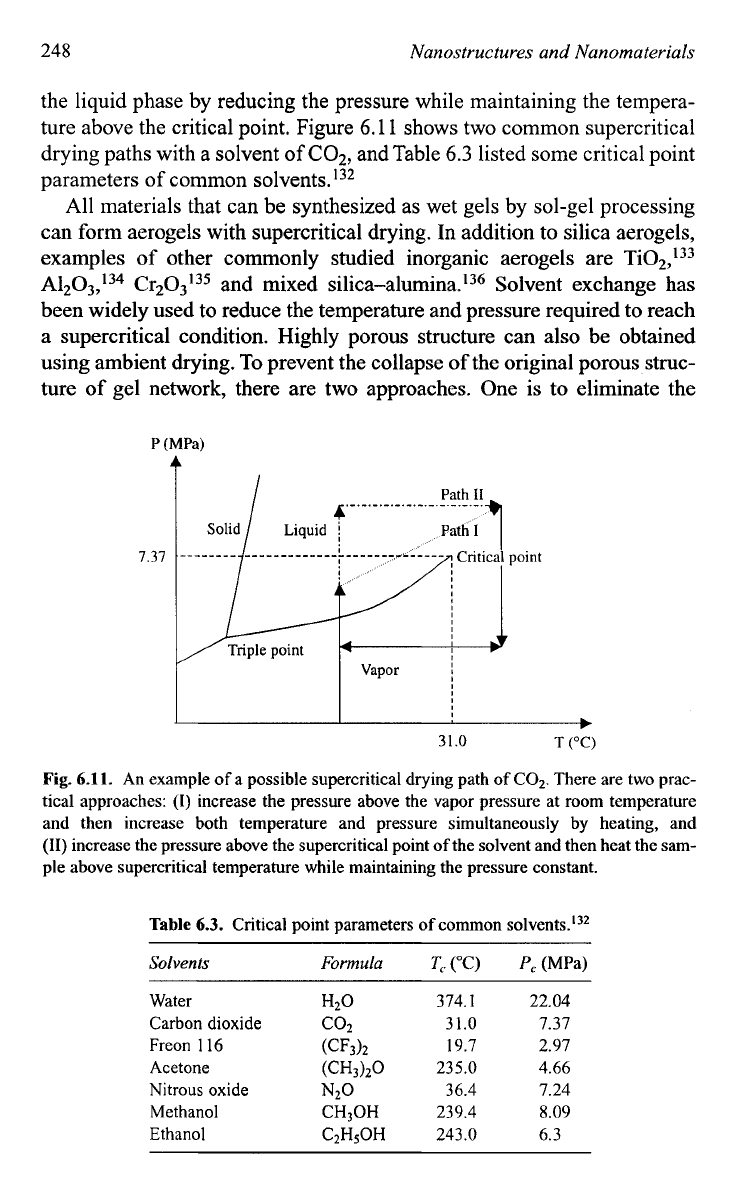
248
Nanostructures and Nanomaterials
the liquid phase by reducing the pressure while maintaining the tempera-
ture above the critical point. Figure
6.1
1
shows two common supercritical
drying paths with a solvent
of
C02,
and Table
6.3
listed some critical point
parameters of common solvents.'32
All materials that can be synthesized as wet gels by sol-gel processing
can form aerogels with supercritical drying. In addition to silica aerogels,
examples
of
other commonly studied inorganic aerogels are Ti02,133
A1203,134 Cr203135 and mixed sili~a-alumina.'~~ Solvent exchange has
been widely used to reduce the temperature and pressure required to reach
a supercritical condition. Highly porous structure can also be obtained
using ambient drying.
To prevent the collapse
of
the original porous struc-
ture
of
gel
network, there are two approaches. One is to eliminate the
P
(MPa)
4
7.31
31.0
T
("C)
Fig.
6.11.
An example
of
a possible supercritical drying path
of
COz. There are two prac-
tical approaches:
(I)
increase the pressure above the vapor pressure at room temperature
and then increase both temperature and pressure simultaneously by heating, and
(11)
increase the pressure above the supercritical point
of
the solvent and then heat the sam-
ple above supercritical temperature while maintaining the pressure constant.
Table
6.3.
Critical point parameters
of
common solvents.'32
Solvents
Formula
T,
("C)
P,
(MPa)
Water H20 374.
I
22.04
Freon
116
(CF3)Z 19.7 2.97
Acetone
(CH3)20 235.0 4.66
Nitrous oxide
N20
36.4 7.24
Methanol CH30H
239.4 8.09
Ethanol C~HSOH
243.0 6.3
Carbon dioxide COZ 31.0
7.37
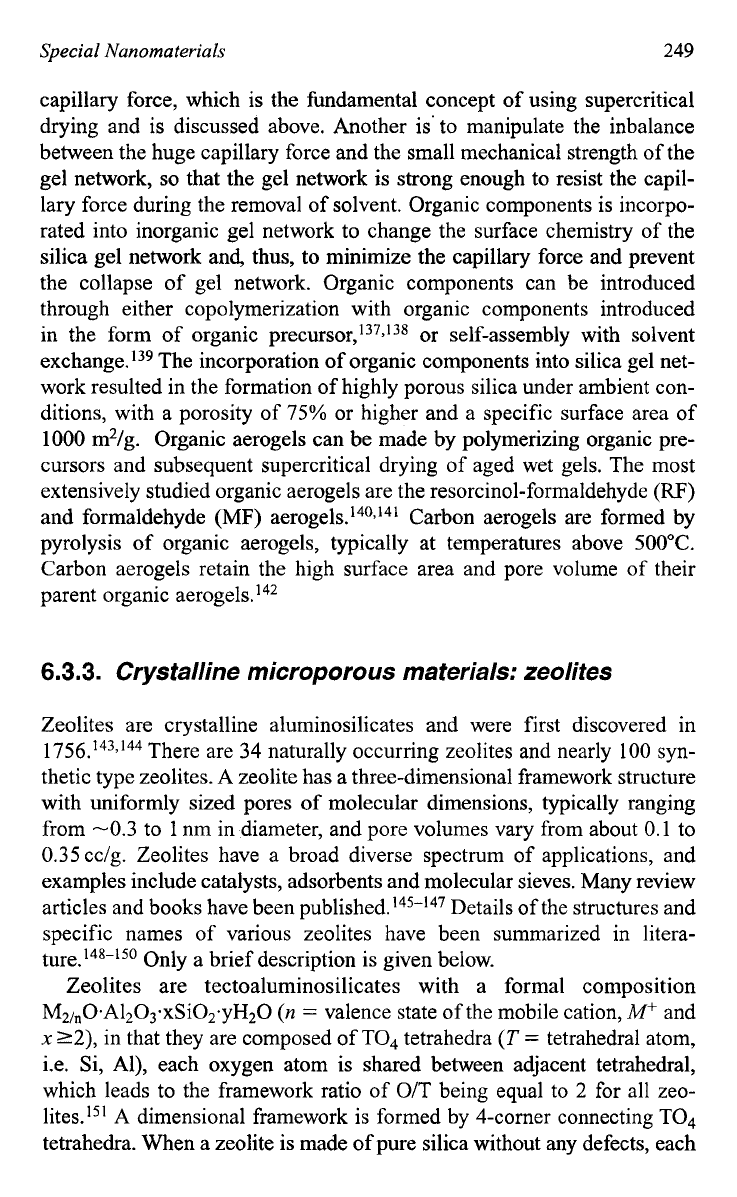
Special
Nanomaterials
249
capillary force, which is the fundamental concept of using supercritical
drying and is discussed above. Another is' to manipulate the inbalance
between the huge capillary force and the small mechanical strength of the
gel network,
so
that the gel network is strong enough to resist the capil-
lary force during the removal of solvent. Organic components is incorpo-
rated into inorganic gel network to change the surface chemistry of the
silica gel network and, thus,
to
minimize the capillary force and prevent
the collapse of gel network. Organic components can be introduced
through either copolymerization with organic components introduced
in the form
of
organic precurs~r,~~~,~~~ or self-assembly with solvent
exchange.'39 The incorporation of organic components into silica gel net-
work resulted in the formation of highly porous silica under ambient con-
ditions, with a porosity of 75% or higher and a specific surface area of
1000
m2/g. Organic aerogels can be made by polymerizing organic pre-
cursors and subsequent supercritical drying of aged wet gels. The most
extensively studied organic aerogels are the resorcinol-formaldehyde
(RF)
and formaldehyde (MF)
aerogel^.'^^,'^'
Carbon aerogels are formed by
pyrolysis of organic aerogels, typically at temperatures above 500°C.
Carbon aerogels retain the high surface area and pore volume of their
parent organic aerogels.'42
6.3.3.
Crystalline microporous materials: zeolites
Zeolites are crystalline aluminosilicates and were first discovered in
1756.143,'44 There are
34
naturally occurring zeolites and nearly
100
syn-
thetic type zeolites. A zeolite has a three-dimensional framework structure
with uniformly sized pores of molecular dimensions, typically ranging
from
-0.3
to
1
nm in diameter, and pore volumes vary from about 0.1 to
0.35cc/g. Zeolites have a broad diverse spectrum of applications, and
examples include catalysts, adsorbents and molecular sieves. Many review
articles and books have been p~blished.'~~-'~~ Details of the structures and
specific names of various zeolites have been summarized in litera-
ture.'48-150 Only a brief description is given below.
Zeolites are tectoaluminosilicates with a formal composition
M2/,0~A1203.xSi02.yH20
(n
=
valence state of the mobile cation,
Mf
and
x
22),
in that they are composed of
TO4
tetrahedra
(T
=
tetrahedral atom,
i.e. Si, Al), each oxygen atom is shared between adjacent tetrahedral,
which leads to the framework ratio of
O/T
being equal to
2
for all zeo-
lite~.'~'
A
dimensional framework is formed by 4-corner connecting TO4
tetrahedra. When a zeolite is made of pure silica without any defects, each

250
Nanostructures and Nanomaterials
oxygen atom at the corner is shared by two Si04 tetrahedra and the charge
is balanced. When silicon is replaced by aluminum, alkali metal ions, such
as
Kf,
Na+, alkaline earth ions, such as Ba2+, Ca2+, and protons,
Hf
are
typically introduced to balance the charges. Such a framework formed is
relatively open and characterized by the presence of channels and cavities.
The size of the pores and the dimensionality of the channel system are
determined by arrangement
of
TO4
tetrahedra. More specifically, the pore
sizes are determined by the size of the rings that are formed by connecting
various numbers of TO4 tetrahedra or
T
atoms. An 8-ring is designated to
a ring comprised
of
8
TO4 tetrahedra and is considered to be a small pore
opening (0.41 nm in diameter), a 10-ring medium one
(0.55
nm), and a 12-
ring large one (0.74 nm), when rings are free of distortion. Depending
on
the arrangement or the connection of various rings, different structures or
pore openings, such as cages, channels, chains and sheets, can be formed.
Figure 6.12 shows some of these subunits, in which each cross point is des-
ignated to a TO4 tetrahedron for ~1arity.l~~ In this figure, the designations
in terms of the n-rings defining the faces of these subunits are also
included. For example, a cancrinite cage subunit
is
defined by six 4-rings
cancrinite cage
[4665]
sodalite unit
or
p-cage
[4668]
a-cavity
[
4
'
26
'8
6]
Fig.
6.12.
Some subunits and cages that recur in several framework types
of
zeolites; each
cross point is designated to a
TO4
tetrahedron where
T
is
a metal such as silicon
or
alu-
minum. [L.B. McCusker and
C.
Baerlocher, in
Introduction
to
Zeolite Science and
Practice,
2nd edition, eds., H. van Bekkum, E.M. Flanigen,
P.A.
Jacobs, and J.C. Jansen,
Elsevier, Amsterdam, p.
37,
2001
.]
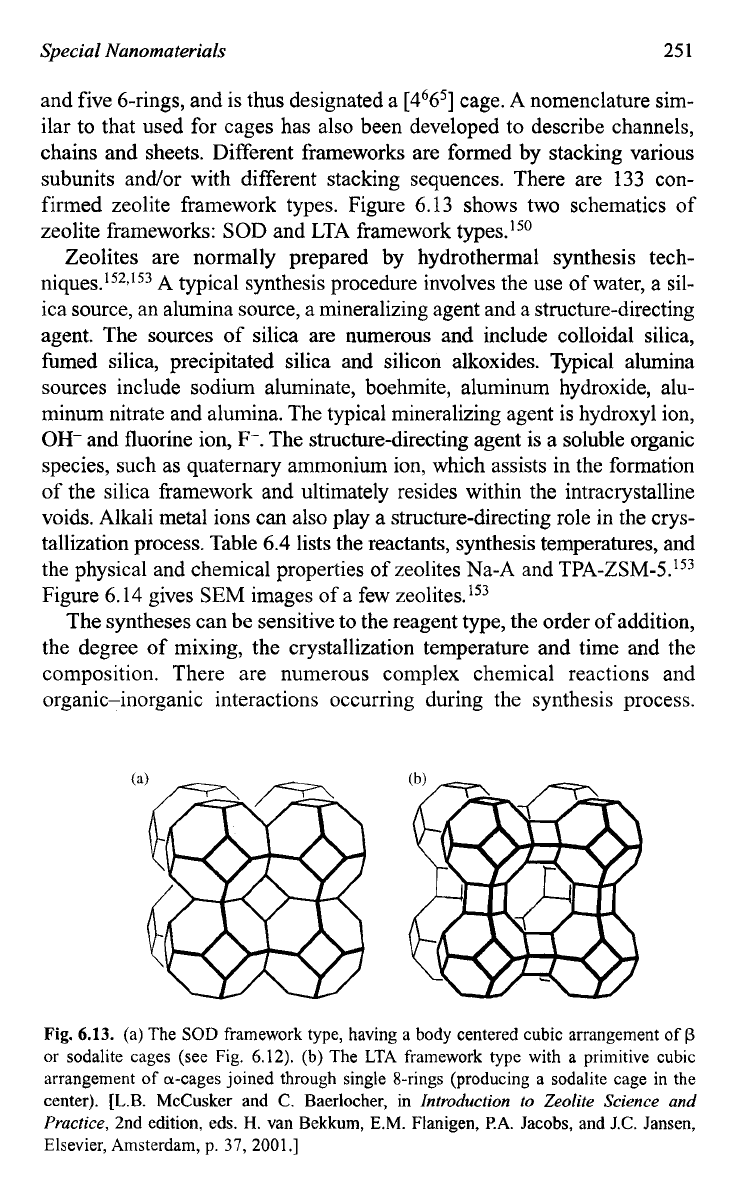
Special Nanomaterials
25
1
and five 6-rings, and is thus designated a [4665] cage. A nomenclature sim-
ilar to that used for cages has also been developed to describe channels,
chains and sheets. Different frameworks are formed by stacking various
subunits and/or with different stacking sequences. There are 133 con-
firmed zeolite framework types. Figure 6.13 shows two schematics of
zeolite frameworks:
SOD
and LTA framework types.'50
Zeolites are normally prepared by hydrothermal synthesis tech-
nique~.'~~?'~~ A typical synthesis procedure involves the use of water, a sil-
ica source, an alumina source, a mineralizing agent and a structure-directing
agent. The sources of silica are numerous and include colloidal silica,
fumed silica, precipitated silica and silicon alkoxides. Typical alumina
sources include sodium aluminate, boehmite, aluminum hydroxide, alu-
minum nitrate and alumina. The typical mineralizing agent is hydroxyl ion,
OH-
and fluorine ion,
F-.
The structure-directing agent is a soluble organic
species, such as quaternary ammonium ion, which assists in the formation
of the silica framework and ultimately resides within the intracrystalline
voids. Alkali metal ions can also play a structure-directing role in the crys-
tallization process. Table 6.4 lists the reactants, synthesis temperatures, and
the physical and chemical properties of zeolites Na-A and TPA-ZSM-5.'53
Figure 6.14 gives SEM images of a few ze01ites.l~~
The syntheses can be sensitive to the reagent type, the order
of
addition,
the degree of mixing, the crystallization temperature and time and the
composition. There are numerous complex chemical reactions and
organic-inorganic interactions occurring during the synthesis process.
Fig.
6.13.
(a) The
SOD
framework type, having a body centered cubic arrangement
of
p
or sodalite cages (see Fig. 6.12). (b) The LTA framework type with
a
primitive cubic
arrangement of a-cages joined through single 8-rings (producing a sodalite cage in the
center).
[L.B.
McCusker and C. Baerlocher, in
Introduction to Zeolite Science
and
Practice,
2nd edition, eds. H. van Bekkum, E.M. Flanigen,
PA.
Jacobs, and J.C. Jansen,
Elsevier, Amsterdam, p.
37,
2001
.]
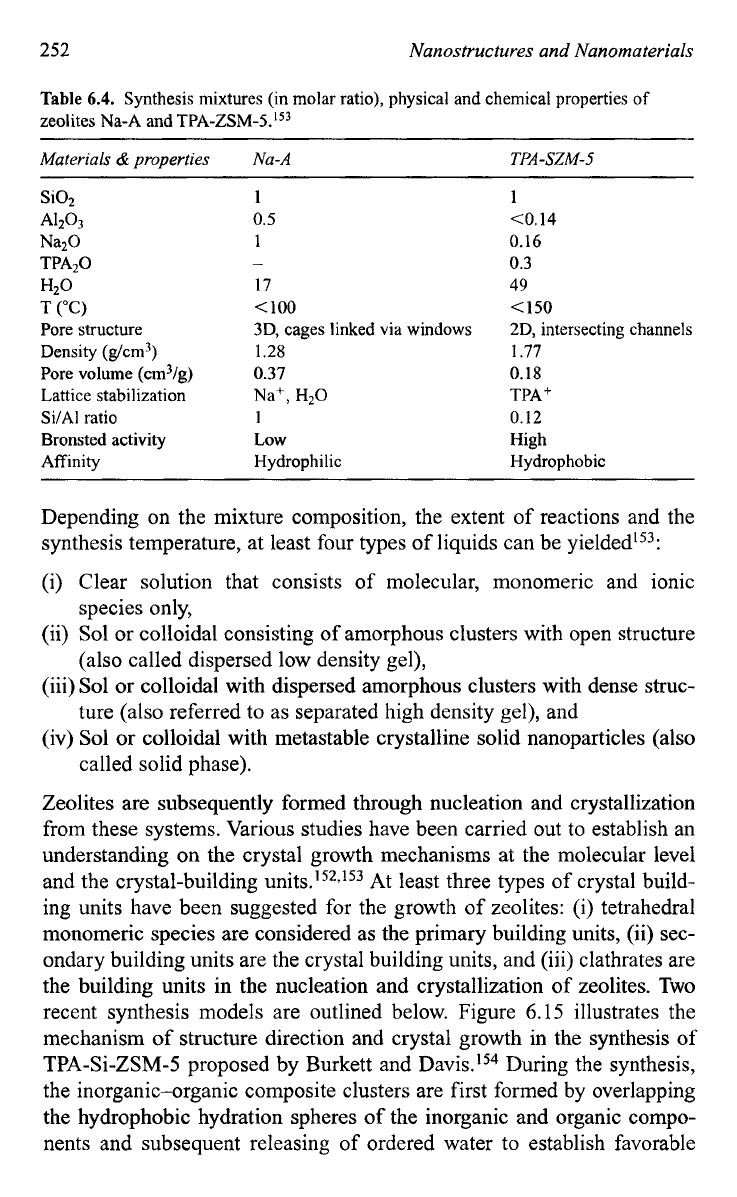
252
Nanostructures and Nanomaterials
Table
6.4.
Synthesis mixtures (in molar ratio), physical and chemical properties
of
zeolites Na-A and TPA-ZSM-5.'53
Materials
&
properties Na-A
TPA-SZM-5
SiOz
NazO
A1203
TPA20
H20
T
("C)
Pore structure
Density (g/cm3)
Pore volume (cm3/g)
Lattice stabilization
Si/AI ratio
Bronsted activity
Affinity
1
0.5
1
17
<loo
3D,
cages linked via windows
1.28
0.37
Na',
H20
1
Low
Hydrophilic
-
1
<0.14
0.16
0.3
49
<150
2D,
intersecting channels
1.77
0.18
TPA
+
0.12
High
Hydrophobic
Depending on the mixture composition, the extent of reactions and the
synthesis temperature, at least four types of liquids can be yielded153:
(i)
Clear solution that consists of molecular, monomeric and ionic
species only,
(ii)
Sol
or colloidal consisting of amorphous clusters with open structure
(also called dispersed low density gel),
(iii) Sol or colloidal with dispersed amorphous clusters with dense struc-
ture (also referred to as separated high density gel), and
(iv)
Sol
or colloidal with metastable crystalline solid nanoparticles (also
called solid phase).
Zeolites are subsequently formed through nucleation and crystallization
from these systems. Various studies have been carried out to establish an
understanding on the crystal growth mechanisms at the molecular level
and the crystal-building
unit^.'^*,'^^
At least three types
of
crystal build-
ing units have been suggested for the growth of zeolites: (i) tetrahedral
monomeric species are considered as the primary building units, (ii) sec-
ondary building units are the crystal building units, and (iii) clathrates are
the building units in the nucleation and crystallization
of
zeolites. Two
recent synthesis models are outlined below. Figure
6.15
illustrates the
mechanism of structure direction and crystal growth in the synthesis of
TPA-Si-ZSM-5 proposed by Burkett and Davis.154 During the synthesis,
the inorganic-organic composite clusters are first formed by overlapping
the hydrophobic hydration spheres of the inorganic and organic compo-
nents and subsequent releasing
of
ordered water to establish favorable

Special Nanomaterials
253
Fig.
6.14.
SEM images showing the crystalline nature
of
zeolites. Single crystals
of
(a)
zeolite A, (b) analcime, and (c) natrolite. (d)
A
batch
of
zeolite
L
and (e) typical needle
aggregates
of
zeolite mordenite. [J.C. Jansen, in
Introduction to Zeolite Science and
Practice,
2nd edition, eds.
H.
van Bekkum, E.M. Flanigen, P.A. Jacobs, and J.C. Jansen,
Elsevier, Amsterdam, p.
175,
2001.1
van der Waals interactions. Such inorganic-organic composite clusters
serve as growth species for both initial nucleation and subsequent growth
of zeolite crystals. The nucleation occurs through epitaxial aggregation of
these composite clusters, whereas the crystal growth proceeds through
difhsion of the same species to the growing surface to give a layer-by-
layer growth mechanism. Another mechanism, called “nanoslab” hypoth-
e~is,’~~ builds on the mechanism discussed above. The difference is that
the inorganic-organic composite clusters form “nanoslabs” through epi-
taxial aggregation first. Such formed “nanoslabs” aggregates with other
“nanoslabs” to form bigger slabs as shown in Fig.
6.
16.’55
Effects of structure-directing agent.
When different organic mole-
cules as structure-directing agents are included in an otherwise identical
synthesis mixture, zeolites with completely different crystal structures can

254
Nanostructures and Nanomaterials
n
V
-
r
crystal
growth
V
Fig.
6.15.
Mechanism
of
structure-direction crystal growth involving organic-inorganic
composites in the synthesis
of
pure-silica
ZSM-5
zeolite using
TPA'
as structure-directing
agent.
[S.L.
Burkett and
M.E.
Davis,
J
Phys.
Chem.
98,4647
(1
994).]
be formed. For example, when N,N,N-trimethyl
1
-adamantammonium
hydroxide is used as a structure-directing agent, zeolite
SSZ-24
was
formed, while
ZSM-5
was produced by using tetrapropylammonium
hydroxide as structure-directing agent. In addition, the choice
of
a structure-
directing agent can affect the synthesis rate.'56
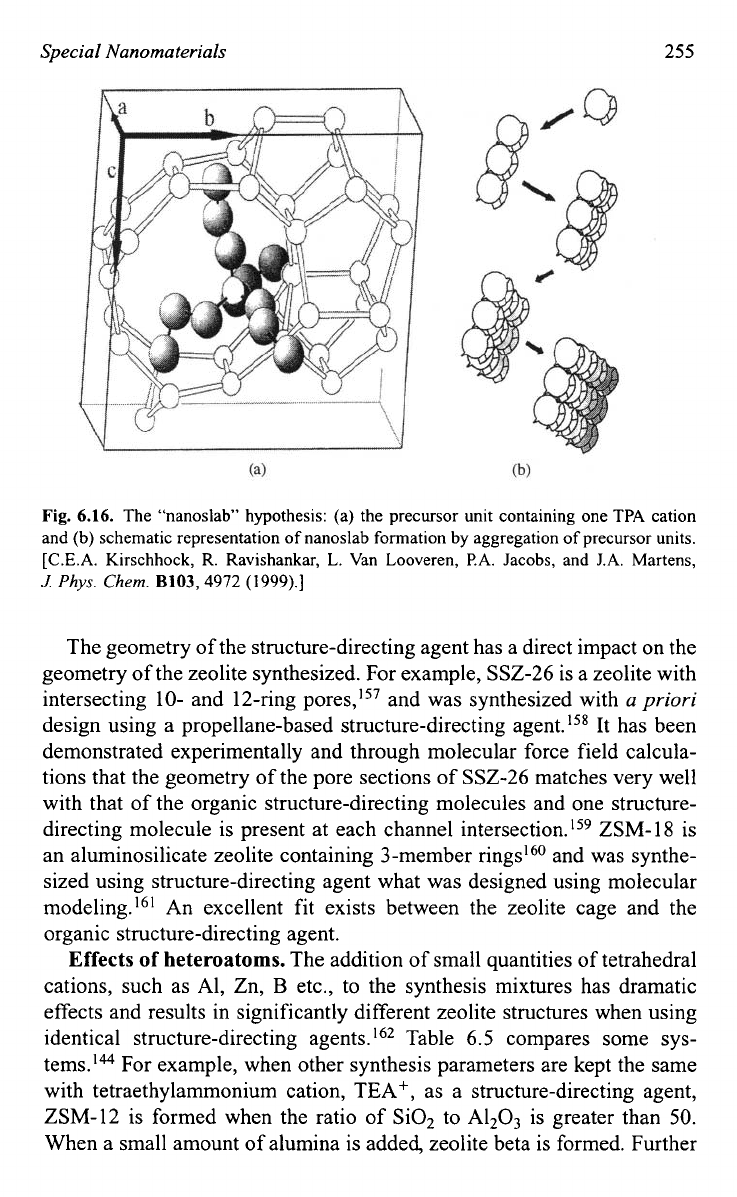
Special
Nanomaterials
255
Fig.
6.16.
The “nanoslab” hypothesis: (a) the precursor unit containing one TPA cation
and (b) schematic representation of nanoslab formation by aggregation of precursor units.
[C.E.A. Kirschhock, R. Ravishankar, L. Van Looveren,
PA.
Jacobs, and
J.A.
Martens,
.I
Phys.
Chem.
B103,4972 (1999).]
The geometry of the structure-directing agent has a direct impact on the
geometry of the zeolite synthesized. For example, SSZ-26 is a zeolite with
intersecting
10-
and 12-ring pores,’57 and was synthesized with
a
priori
design using a propellane-based structure-directing agent.
158
It has been
demonstrated experimentally and through molecular force field calcula-
tions that the geometry of the pore sections of SSZ-26 matches very well
with that of the organic structure-directing molecules and one structure-
directing molecule is present at each channel intersection.
159
ZSM-
18
is
an aluminosilicate zeolite containing 3-member rings’60 and was synthe-
sized using structure-directing agent what was designed using molecular
modeling.16’ An excellent fit exists between the zeolite cage and the
organic structure-directing agent.
Effects of heteroatoms.
The addition of small quantities of tetrahedral
cations, such as Al, Zn,
B
etc., to the synthesis mixtures has dramatic
effects and results in significantly different zeolite structures when using
identical structure-directing agents.’62 Table 6.5 compares some sys-
tems.Iu For example, when other synthesis parameters are kept the same
with tetraethylammonium cation, TEA+, as a structure-directing agent,
ZSM-12 is formed when the ratio of SO, to A1,0, is greater than
50.
When a small amount of alumina is added zeolite beta is formed. Further
